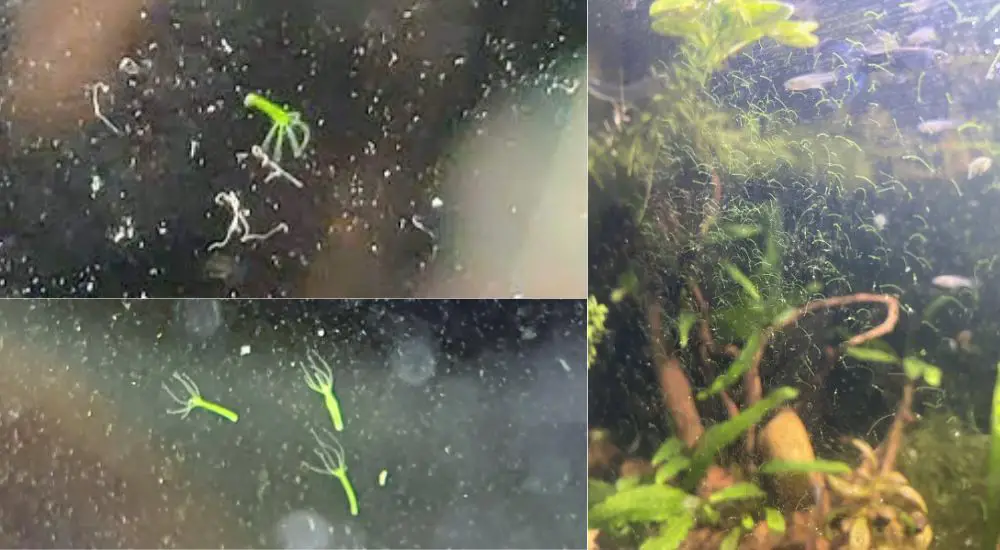Hydra, those small, tentacle-waving creatures, may not be the menacing monsters of the aquatic world, but they can quickly become a nuisance in your aquarium. If left unchecked, their numbers can disrupt the balance of your carefully maintained ecosystem. Don’t worry, though; there are effective ways to tackle these unwelcome guests. In this comprehensive guide, we’ll explore the nature of hydra and tips on how to get rid of hydra in aquarium easily.
Key Takeaways
- Hydra in aquariums can harm your fish and take over your tank if not treated.
- It’s crucial to identify and remove hydra as soon as possible to prevent further infestation.
- There are various methods for getting rid of hydra, including physical removal, chemical treatments, and natural remedies.
- Regular maintenance and monitoring of your aquarium can prevent hydra infestations in the future.
- Consulting with a professional or experienced fish owner can provide valuable insight on how to get rid of hydra in your specific aquarium setup.
Understanding Hydra
Before diving into the removal strategies, let’s get to know your tiny adversaries a bit better. Hydra are aquatic organisms belonging to the family Hydridae. They are related to jellyfish and corals and are primarily found in freshwater environments, including aquariums. Hydra are typically very small, ranging from 0.1 to 0.4 inches in size, and have a unique structure that includes tentacles surrounding a central body column.
The Hydra Life Cycle
Hydra have an intriguing life cycle. They reproduce both sexually, by producing eggs and sperm, and asexually, through a process called budding. This means that even a single hydra can rapidly multiply and populate your aquarium. Their asexual reproduction makes them particularly challenging to control once they’ve established themselves.
The Impact of Hydra in Your Aquarium
While hydra may not pose a direct threat to your fish, they can indirectly affect the overall health of your aquatic ecosystem. Here’s how:
- Disrupting the Balance: Hydra can outcompete other small aquatic organisms, such as daphnia or copepods, for food resources, throwing off the balance of your tank.
- Irritation to Fish: Though rare, some species of hydra may sting or irritate fish. This can stress your fish and potentially lead to health issues.
- Algae Growth: An overabundance of hydra can indicate excess nutrients in the water. This can also contribute to excessive algae growth, affecting the aesthetics of your aquarium.
Now that we’ve understood the problem, let’s explore effective ways to tackle it.
Tips on How To Remove Hydra
1. Manual Removal
- Scraping: Gently scrape hydra off the tank’s glass or any decorations they cling to. Be careful not to rupture them, as this can release more hydra.
- Siphoning: Use a siphon to remove hydra from the tank. Be sure to clean the siphon thoroughly afterward.
2. Temperature Adjustment
- Gradually raising the tank temperature to around 86°F (30°C) can help eliminate hydra without harming your other aquatic life. However, ensure that your fish and other inhabitants can tolerate this change.
3. Hydra-Targeted Medication
- There are anti-hydra medications specifically designed for aquarium use. Follow the manufacturer’s instructions carefully, as overdosing can harm your fish.
4. Reduce Overfeeding
- Hydra often thrive on excess food. Adjust your feeding habits and avoid overfeeding, as this can help reduce the nutrient supply that hydra feed on.
5. Introduce Predatory Fish or Invertebrates
- Some fish and invertebrates, like bettas, gouramis, and certain snails, are known to prey on hydra. Introducing these natural predators can help keep their population in check.
6. Quarantine and Sterilize New Additions
- Before introducing new plants or fish into your tank, quarantine them and ensure they are free from hydra. Sterilize new additions to prevent an outbreak.
7. Improve Filtration
- Enhance your tank’s filtration system to remove debris and reduce excess nutrients in the water, which can contribute to hydra growth.
8. Maintain Water Quality
- Regular water changes and upkeep of proper water parameters can help create an environment less favorable for hydra.
Conclusion
Eliminating hydra from your aquarium is a crucial task to ensure the well-being of your fish. By following the tips provided in this article, you can effectively control and remove hydra infestations from your aquarium. Remember to regularly maintain your aquarium and monitor the water quality to prevent future hydra problems.
Proper care and attention will ensure a safe and hydra-free environment for your fish. Don’t hesitate to use fish tank equipment and treatments to eliminate hydra infestations. With patience, persistence, and a little effort, you can enjoy a beautiful and thriving aquarium.
FAQs About Hydra in Aquariums
Q. What is a hydra in an aquarium?
Hydra is a small aquatic organism resembling a jellyfish, often found in freshwater aquariums.
Q. Do hydra harm fish?
While they can sting, hydra usually don’t harm fish significantly.
Q. How can I prevent hydra in my aquarium?
Maintain good water quality, avoid overfeeding, and quarantine new additions.
Q. Can I manually remove hydra from the tank?
Yes, gently scrape or siphon them off tank surfaces and decorations.
Q. Are hydra treatment chemicals safe for fish?
When used correctly, treatment chemicals are generally safe, but follow dosage instructions to avoid harming your fish.

